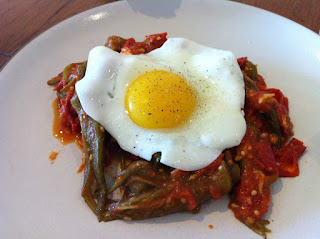Drinking Sherry Over Several Days - Further Experiments in Brooklyn Prove Useful.
Sherry improves for a few days after opening. I know, this goes against what we've all heard for decades. But it's true, especially if we are talking about quality brown Sherries that are shipped carefully. After hearing about this for a while I experimented a bit in early 2012 and confirmed this idea. Now I routinely open a brown Sherry (Palo Cortado, Amontillado, and Oloroso) several days in advance of the night on which I plan to drink it.
What about other kinds of Sherry - do they also improve over several days? Recently I decided to experiment with a bottle of Sherry that has no official category, but we might call it a Fino-Amontillado. This is a Fino Sherry whose wines are old enough (perhaps 8-12 years) in which the flor has begun to die, and it thins and becomes patchy, no longer fully protecting the wines from oxygen in barrel. The wine begins to take on a darker color and a certain richness that comes with oxidative aging. But although it has some of the characteristics of Amontillado it is not yet Amontillado, and retains much of the brisk Fino style. This style, Fino-Amontillado, is a favorite of many Sherry aficionados, for whatever that's worth, including singer Paula Abdul, the magician Gallagher, and wine writer Peter Liem.
Please let me say that La Bota Nº 24 is an utterly amazing wine, one of the most compelling that I've tasted from the La Bota series. Peter said that it may have been lost in the La Bota shuffle, it may have been overlooked. It is a tremendously beautiful wine with such finesse and grace, such intensity, such detail of aroma and flavor. It was beautiful a year ago when I first tasted it and it continues to improve. Fino-Amontillado is a style of Sherry that is really worth seeking out if you haven't tried one. La Bota Nº 24 is basically sold out, but you can probably find a bottle if you look hard. You might also try Emilio Hidalgo Fino La Panesa, a wine made in the same style, or a Manzanilla Pasada such as La Bota Nº 30, which inexplicably continues to grace some retail shelves in NYC.
Okay, so what happened here, drinking this bottle over several days? The experience was a bit different from slowly drinking a brown Sherry. Brown Sherry improves over several days - it is better on day 3 than it is on day 1, for example. La Bota Nº 24 changed over the course of a week, and it never faded in that time. My sense is that it neither improved nor declined, it just changed. In the first few days the flor is more apparent on the nose and the palate, showing a lemony and almost creamy aspect. But after a few days the Amontillado characteristics become more pronounced and the wine shows a nutty richness and pungent salted caramel tones, the finish becomes less creamy and rings out with a complex oxidative tang. The wine always carried itself with finesse and grace, but the particulars changed, like a woman with innate class wearing different outfits.
This proves nothing, I'm aware. This is a wine blog, not The Lancet. Still, the more I drink Sherry the more I find pleasure in aging it in bottle, and then in drinking it slowly over several days.

























